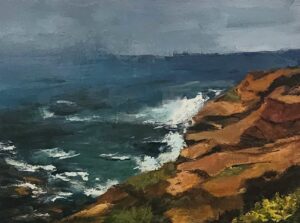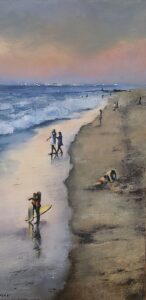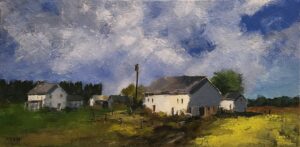Linda Reedy grew up in Connecticut and Boston and first came to Provincetown when she was seven. For her parents, it was the nearest far-away place. The briny breezes, scrub-pine sandscape, and sweeping skies of the Outer Cape stayed with her. She returned with high school buddies. Later, as a studio art major at Emmanuel College, she was influenced by the paintings of the late Wellfleet artist Edwin Dickinson.

Reedy continued her education with courses at the Massachusetts College of Art and a residency at the Fine Arts University of Hanoi, Vietnam. She is now an established artist living in Fort Worth, Texas. She returns to Provincetown each summer, working en plein air and absorbing the atmosphere that fills her paintings. An exhibition of her recent works will be on view from June 27 through July 10 at Alden Gallery in Provincetown, where Reedy has exhibited since 2008.
Q: You have a blank canvas on the easel. Where do you begin?
The large shapes are painted first, or the shapes that will be the focal point.
Q: What ideas or intentions are guiding you?
I aim to reveal quiet paintings that reflect a sense of time, place, and above all, tranquility. In Dunes Hamlet, the two cottages nestled in the sand create a pathway to a third one, standing apart. I hope a viewer gets a sense of the dunes, their human habitation, and peaceful loneliness. I love painting a house, not for the subject matter but out of my own curiosity about what goes on inside the structure, the life hidden from view.

Q: What led you to painting with oils?
At first, I was known as a weaver. I taught weaving and had a yarn shop. The textures and the freedom of creating patterns and colors drew me in. It also led me to another way of using color and texture and the possibilities of painting. I’ve used watercolor on silk and experimented with gouache and acrylics. But I love oil paints the best — how the paint moves around and how creamy it is.

Q: You’re known for the softness of your palette. When you first started painting, what artists appealed to you?
The Spanish painter Joaquín Sorolla was someone I looked at in art school for his luminous atmosphere and vibrant colors. There is also J.M.W. Turner, especially his watercolors, for the atmosphere he creates with only a few brush strokes, and Edward Hopper, for the mystery of his subjects. Then there is Edwin Dickinson. He was misunderstood by critics who found his palette monotonous. For me, his ability to create what we call gray by using a mixture of colors was a revelation.
Q: In Dunes Hamlet there is a feathery, dancer-like quality to the sky. How did you approach creating the color above the horizon?
In using similar shapes and colors, I wanted the brightness of the clouds to reflect the golden colors of the landscape. The clouds also provide a sense of serenity, as they hover above the dunes with their barren masses of deep greens and browns. Land and sky complement each other, both contrasting and connecting.

Q: As a painter, what’s on your horizon?
Right now, I am in a transitional place. I’ve started to add a few figures, to capture a sense of motion. My paintings are also a little brighter and a little less abstract. I am working more with color than in the past. I’m excited to see where it all goes.
Time, Place, and Tranquility
The event: An exhibition of paintings by Linda Reedy
The time: June 27 to July 10; opening reception Friday, June 27, 7 to 9 p.m.
The place: Alden Gallery, 423 Commercial St., Provincetown
The cost: Free



